

Resilience. Something often talked about in communities impacted by volcanic activity. An elusive diamond to be found that enables one to make like Chumbawamba and ‘get up again’ when there are challenges in life. As we are all learning with COVID19, the same challenge is experienced differently according to the prevailing circumstances into which that challenge is set. For example, lockdown is not the same for those of us in a solitary warm booklined study with a high speed internet connection as it is to those with an angry school-deprived child crawling onto knees and demanding attention. In the same way, the launch and execution of a research career is not always the same despite the apparent presentation of the same opportunities. These are silently shaped by prevailing attitudes and the circumstances of that individual. To be successful, some have to be just that little bit more resilient than others. We need to change that and work more explicitly towards not only providing opportunity but towards removing barriers to inclusion and diversity in our community.
In that spirit we bring a Newsletter focussed on Equality, Diversity and Inclusivity (EDI) and how we are using this closed down world to take positive steps to forming a community that does better with EDI. There is ample evidence to suggest that a more equal, diverse and inclusive community is more creative, and better at solving problems.
Finally for those enjoying skipping into the fields of freedom in Scotland, we have another field excursion to savour, and for those currently more basaltically-challenged in England our Newsletter includes an introduction to the wonderful faux-volcanic world of slag.
In the last VMSG Newsletter, we presented equality, diversity and inclusivity (EDI) information gathered from the recent annual winter meeting in Plymouth (January 2020). This data forms part of a larger study that looks at EDI within the VMSG community and at recent VMSG annual meetings. Here, we provide a short overview of the EDI findings together with some of the resultant recommendations for future VMSG meetings. We will publish the results of the full EDI Report and VMSG Survey soon.
The 2020 VMSG Annual Survey was the first time we have asked our members to tell us about themselves, their careers, their experiences and their thoughts on a wide range of VMSG activities. The 110 respondents were asked how much they thought the VMSG were doing in terms of promoting equality and diversity in the community. There were 95 responses to this question, and 74% thought the promotion was “About right”, 14% thought “Too little” was being done and 5% selected both “Too little” and “About right” (Figure 1).

Figure 1. Percentages of response to the question “How much do you think VMSG is doing in terms of promoting equality & diversity in the community?” (95 responses)
We were able to do additional analyses to look at the responses according to other factors such as the career stage of the respondent (Figure 2). From these responses, proportionally more early career stage individuals (<10 years since PhD), undergraduates, Masters students, PhD students and Postdoctoral researchers thought that “Too little” was being done to promote diversity and equality. More of the advanced and mid academic career individuals responded with “Don’t know/No idea/Not sure”, and only permanent academic staff and early academic career individuals thought “Too much” was being done. This additional analysis demonstrates the importance of considering the responses not only as a bulk dataset but also to separately look at the views of minority sub-groups, whose thoughts may otherwise become obscured by those of the majority.

Figure 2. Percentages of response per ‘Career Stage’ to the question “How much do you think VMSG is doing in terms of promoting equality & diversity in the community?” (95 responses)
To assess EDI at VMSG annual winter meetings, the committee gathered and analysed available attendance data for the past six years of meetings (Figure 3). This represents the time frame for which we have data and allowed us to assess trends in attendance, oral presentations and keynote speakers over this time. The information was not specifically acquired for EDI analysis and, due to data availability, we have only been able to focus on gender. The analysis shows that the proportion of female oral presenters has varied over the 6-year period with an average of 37%. This is in comparison to the proportion of female attendees which has averaged at 47%. There is, however, only very limited data to show how these values relate to proportions of requested oral presentations but we note that in 2018 and 2019 there were fewer requests from female attendees for oral presenters. These trends can be seen to directly impact the distribution of presentations, particularly in 2019. Gathering such information is important because it allows both the committee and community to identify areas where diversity is lacking, but more information is required to fully capture and understand factors that affect trends through time.

Figure 3. Percentages of attendees and oral presenters at VMSG annual meetings since 2015. Data for the number of requests for male/female attendees is only available for VMSG 2018 and 2019.
Our analysis of data for the EDI report highlights the large gaps in the available data, for example, on the representation of BAME and LGBTQ+ communities. In the future, we endeavour, through working with local conference organising committees, to collate more diverse information and so gain a greater understanding of the VMSG community. We hope that through the collection of such data, and the recommendations provided in the report, the VMSG committee and community as a whole can work together to make meetings increasingly diverse, equal and inclusive.
Making real changes in equality, diversity and inclusivity requires more than data collection and analysis. In order to effect change, we have used the EDI analysis to update our ‘Guidelines for VMSG meetings’. As many VMSG members will be aware, we have also recently introduced a Code of Conduct policy for our meetings and field trips.
And last but not least, a new initiative by the VMSG Committee has been to appoint Prof Jenni Barclay as our dedicated Public Engagement and Outreach Officer. As demonstrated by recent well-attended public lectures in Dundee (Sir Prof Steve Sparks & Prof Rosaly Lopes) and Plymouth (Prof Iain Stewart) the study of volcanoes and magmas on Earth and other planets offers lots of potential to engage with under-represented groups. Jenni will actively work alongside the VMSG community to develop new inclusive outreach events, and we really welcome your ideas and participation in these activities.
At the end of this Newsletter, you will see the ‘Call for a Robust Anti-Racist Action Plan from all Professional Geoscience Societies and Organisations’ that has now been signed by over 24,000 individuals. This was originated in the USA but is well worth a read. There is a link here too, to sign the associated petition.
Drawing on this Action Plan (and noting our own lamentable diversity) we have been determined to take action.
As our contribution to #BlackLivesMatters we will convene a series of web-based discussion panels. These will acknowledge:
(i) The historical construction of inequalities in our research field globally (Origins)
(ii) Learn about the barriers to inclusion (The problem today)
(iii) Co-create a manifesto for tangible actions for VMSG moving forwards (The Future).
With these discussion panels we need to ‘do work’ to understand how we are part of the problem, and consider how VMSG can be part of the solution. Where we ask for contributions from community members from ethnic minorities in the UK or colleagues from overseas, we will acknowledge and amplify that effort. These three discussion panels will each last around 90 minutes.
The first of these will be on Monday the 20th of July. Entry is via registration but its easy to do and you can sign up here.
Origins: understanding the impacts of historical inequalities in research undertaken by the Volcanic & Magmatic Studies Group community.
Our five invited panellists (*) will explore the historical construction of inequalities in accessing research, the benefits gained from resources overseas (volcanological, mineralogical, petrological and geochemical) and how we might avoid ‘parachute’(**) science in the wake of these privileges. After introductory plenaries from our panel (~1 hour) we will use the virtual format to gather discussion topics and questions from all participants and together consider how future practice in research might improve benefits for vulnerable communities and scientists in the countries where we work.
(*)Panellists: Jazmin Scarlett, University of Newcastle; Elisa Sevilla, Universidad San Francisco de Quito; Kathryn Goodenough, British Geological Survey; Matthieu Kervyn, Vrije Universitiet, Brussels; Richie Robertson, University of the West Indies.
(**) parachute science: where we do research or fieldwork without involvement or acknowledgement of local scientific or non-scientific expertise. See: https://www.scientificamerican.com/article/the-problem-of-colonial-science/ for an example in Conservation.
The remaining two panels will convene later in August and September.
Like many geosciences PhD students, it was the fantastic experiences that I had as an undergraduate, particularly those that involved fieldwork, that provided inspiration for me to pursue a career in research. However, gaining these experiences required the negotiation of some of the barriers that academia can present to the inclusion and success of individuals with disabilities, including those who, like me, are autistic.
At the moment, disabled individuals are underrepresented within academia. But diverse research is better research, diverse research teams produce more, and more highly cited, research papers, and we should strive for an inclusive research culture where thinking differently is promoted, and where the enjoyment that research brings can be shared with as many people as possible. So here are three challenges that academia can present to the success of autistic individuals, and simple solutions to help make the future more inclusive.
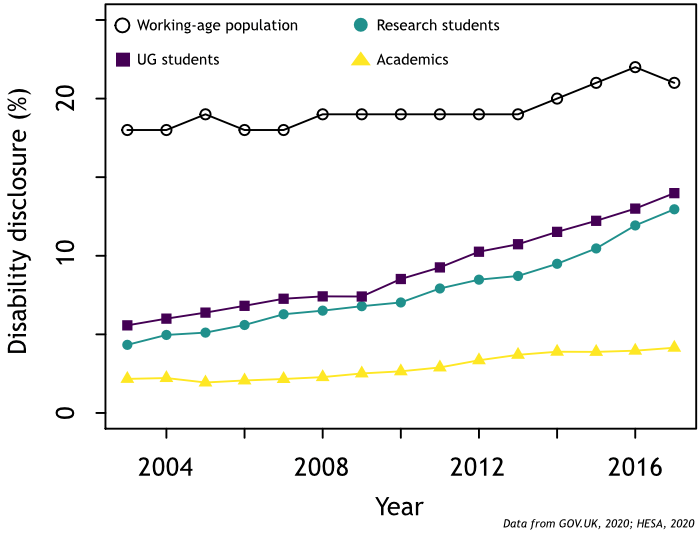
A comparison of disclosure of disability between the working-age population and different academic stages between 2003 and 2017. Data are from HESA (www.hesa.ac.uk)
1. A core feature of autism is difficulty with social interactions. It can seem like everyone is talking a different language, which takes time to “tune in to” and understand, and it might also be difficult to communicate verbally with others. Being clear, precise and literal, and allowing time to respond can make a huge difference. Group discussions can be made far easier when a chairperson gives everyone the opportunity to contribute (even if they need more time to do so, or to communicate in a different way) and periodically summarises discussions to ensure a collective understanding.
2. Integrating with peers. As a researcher, relationships with colleagues are important for both social and academic purposes – and can be difficult for autistic individuals who are likely to be excluded by their peers. This rejection often stems from a lack of awareness, necessitating disability awareness training. Peer integration can also be promoted by allocating groups, so no one gets (unintentionally) excluded, and by having some structure to social (or other) events, making them easier to join in with.
3. Busy environments. Around 95% of autistic individuals have sensory differences; this can make every sound and every voice amplified, and background noise impossible to ignore. Light, smell, touch and taste can also all be distracting, if not overwhelming. These sensitivities can make conference environments, travel hubs and busy teaching laboratories overwhelming, and impossible to concentrate in. COVID-19, has, at least temporarily, had a revolutionary effect on conferences, and the alternative online events are more accessible to many people who struggle within busy environments. For in-person events, access to additional rooms (allow for discussion outside the busiest areas, and an area to unwind), good signage (helps with navigating unfamiliar locations) and extending the length of poster sessions (reducing crowding) can be particularly helpful.
As part of the Equality and Diversity special issue of Advances in Geosciences, my supervisor (Dr Jess Johnson) and I contributed an article about autism within academia that expands on the ideas here – available at adgeo.copernicus.org/articles/53/33/2020/ for those who want to read more!
It is a little-known fact that we have a National Slag Collection! Much better than visiting an archive is getting out in the field to study slag. If you are fortunate enough to have iron slag tips nearby you may well have a wonderful volcanological educational resource to hand and maybe for research as well? Around twenty million tons of extracted Cumbrian iron ore has littered the coast with fantastic volcanological experiences from just into Lancashire to beyond Workington. Ropy pahoehoe flow fields, lava stalactites, spinifex textures, magma fragmentation, vesiculation patterns, and much more, can be studied in these locations. Though Hawaii might seem more exotic, and have a magnetic attraction, field trips still use the Lake District but how many will have included a visit to a slag tip? This contribution shows what they have missed.
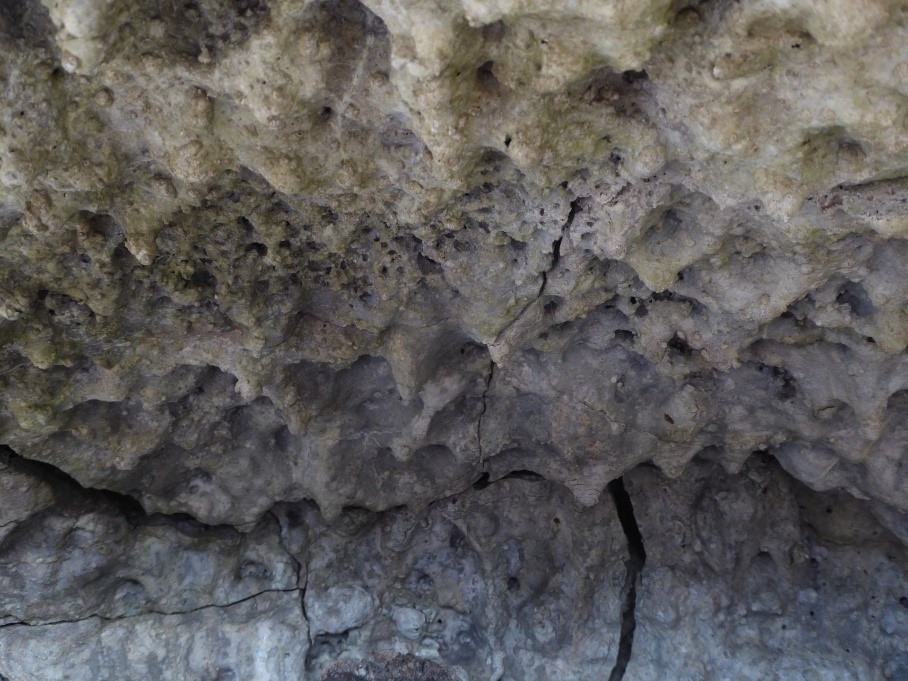
Lava stalactites on the roof of a cavity in a tipped pudding, Workington.
Specially constructed railway wagons conveyed the slag from iron and steel works to tips. The tipped contents of the wagons are variously referred to as skulls or puddings and many remained intact after dumping. Because of primitive design, in the early days, it paid to deliver the slag to the dump either totally solid or with very little liquid but there are later examples where the tipped material was totally fluid such as at Askam. The seaward end of Askam Pier is covered in thin (~10 cm) ropy pahoehoe flows with not much sign of solidification before tipping. Early tipping at many locations left essentially intact puddings with variable volumes of cavities. Liquid from the residual cavities produced dribbles of magma and some have lava stalactites on their roofs. A range of cooling contraction granulation patterns can be seen in a spectrum of stages of disintegration leading to clear examples of reverse-grading grain-flow sorting in the tips just like scoria cones.
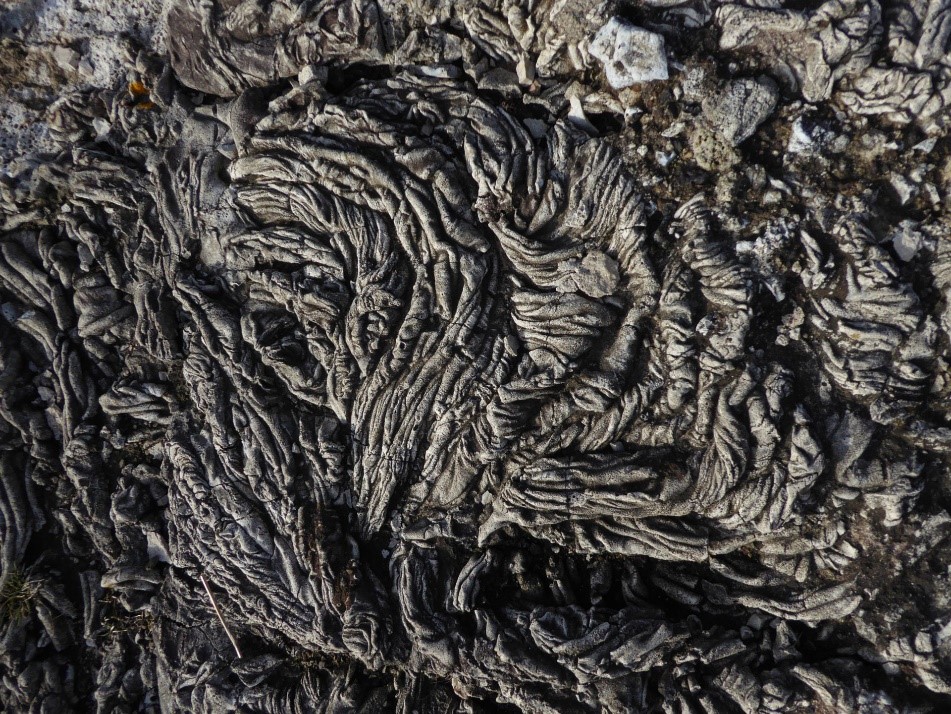
Twisted ropy pahoehoe as part of a pahoehoe flow field, Askam Pier.
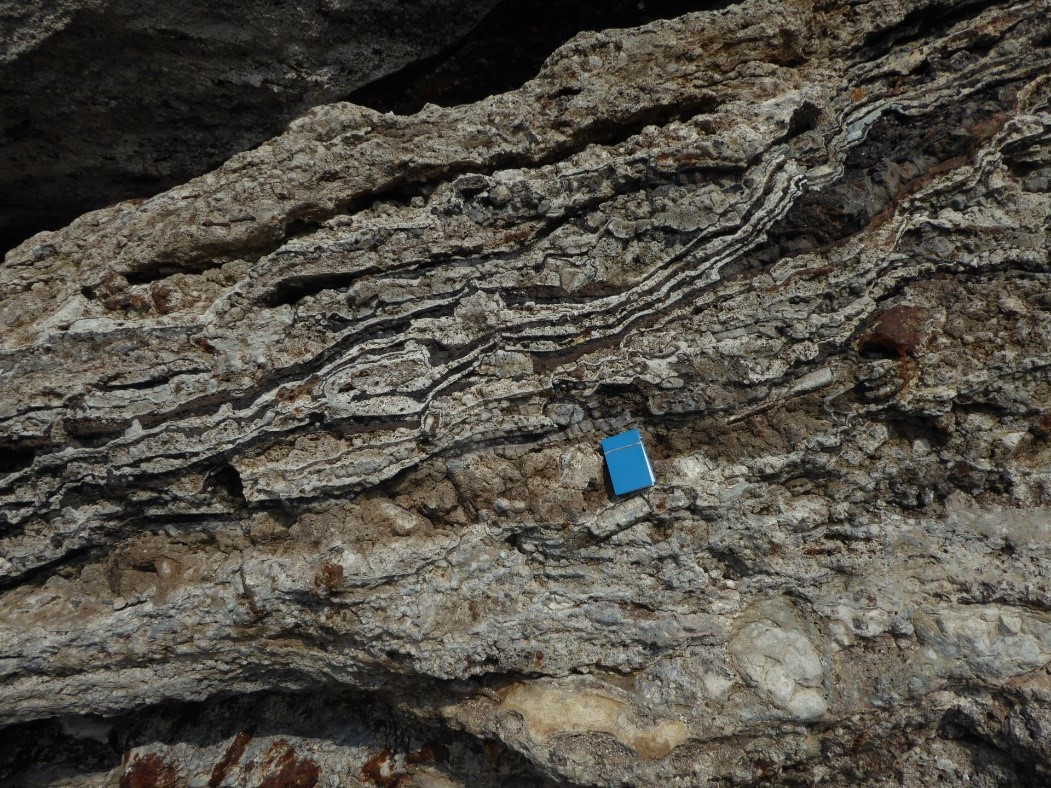
Thin lava flows at Workington. The white upper part of each flow has pahoehoe structure [scale 10.5×16.5 cm]
Slag tips in Cumbria provide a good opportunity for geologists to examine spinifex texture without the need to travel to distant places like South Africa and Western Australia. Also the mineralogy in the slag is fresh unlike the Archaean examples. Bladed/oriented olivine crystals (max. 20 cm long seen in Cumbria) and randomly oriented spinifex are commonly found on the tips. Being an Archaean geologist it was finding spinifex textured slag on the beach at Hest Bank that got me into searching out its source. It is similar to the Raventhorpe slag in Western Australia that played a key role in our understanding of the nature of komatiite lava flows back in the late 1960s.
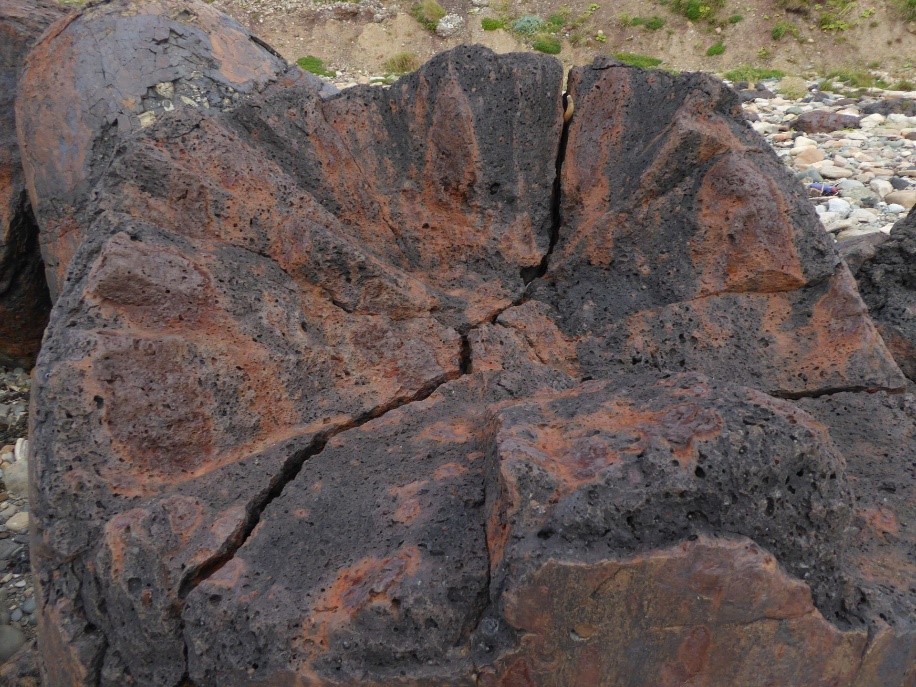
Radial fractures in a pudding at Workington mimicking a cracked open Teide’s Egg.
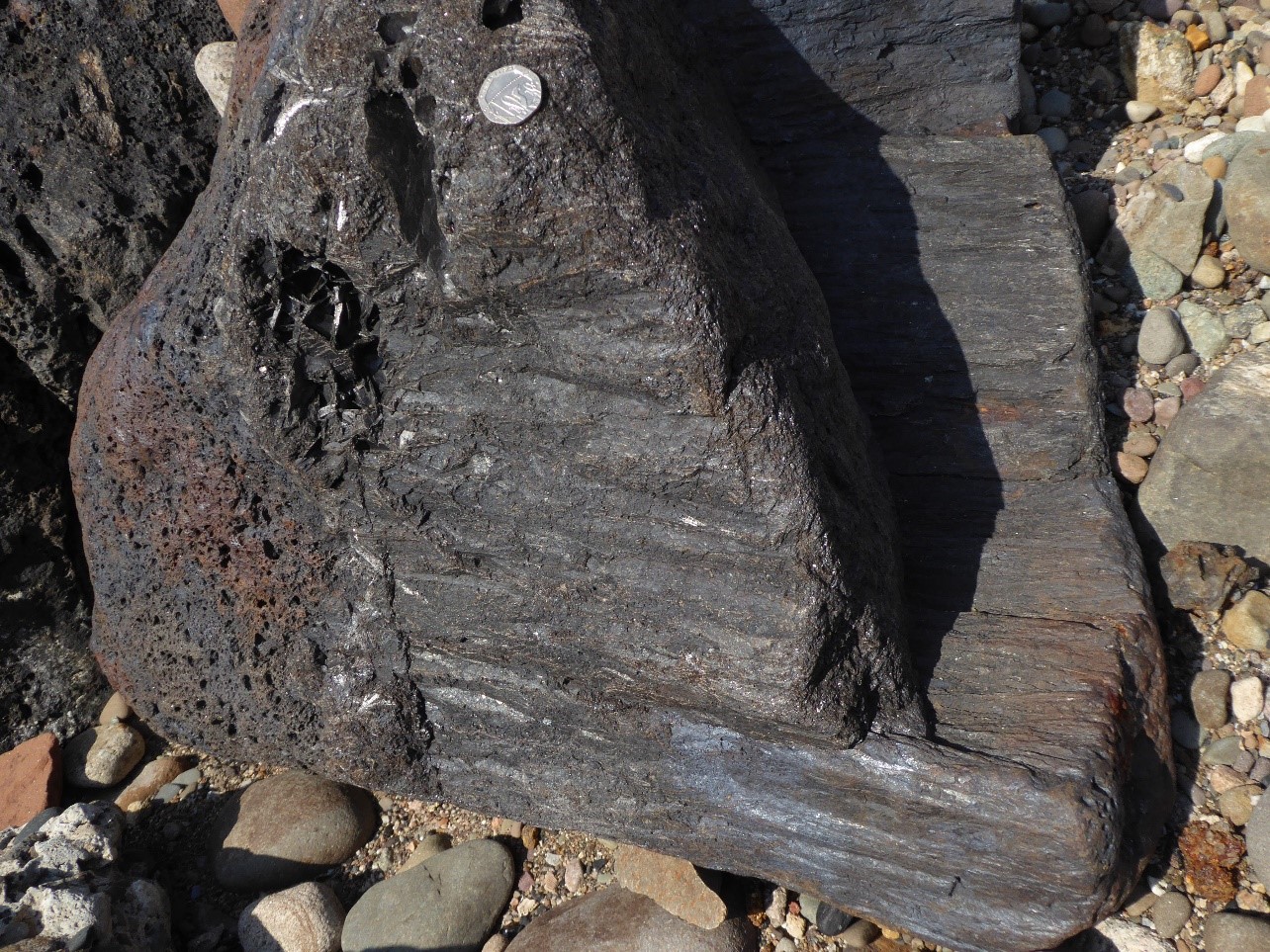
A block of spinifex textured slag with bladed and randomly oriented olivine together with vesiculated slag (Workington).
An excursion guide to the Workington localities is in the first issue of the Cumberland Geologist, 2020, pp. 59-62. An account of the slag at Workington, Carnforth, is in the 2018 Proceedings of the Westmorland Geological Society pp. 45-49.
Around 330 million years ago, Scotland lay near the Equator. River sands, estuarine muds and marine lime were deposited in large deltaic areas forming sandstone, shale and limestone. Coal formed from the decay of tropical forests. Later violent volcanic activity ca. 295 million years ago punched through these rocks which had also been folded by crustal compression. Erosion has since revealed the underground volcanic “plumbing”.
On the wave cut platform by Elie harbour, concentrically-dipping layers of tuff form a dark coloured “lunar” landscape. Here we are inside a volcanic neck which was collapsing inwards on itself. Each layer of ash represents a volcanic eruption, showing that there were multiple eruptions. The tuff contains many blocks of basalt from previous eruptions, as well as calcite veins formed from fluids intruding the tuff while it was cooling.
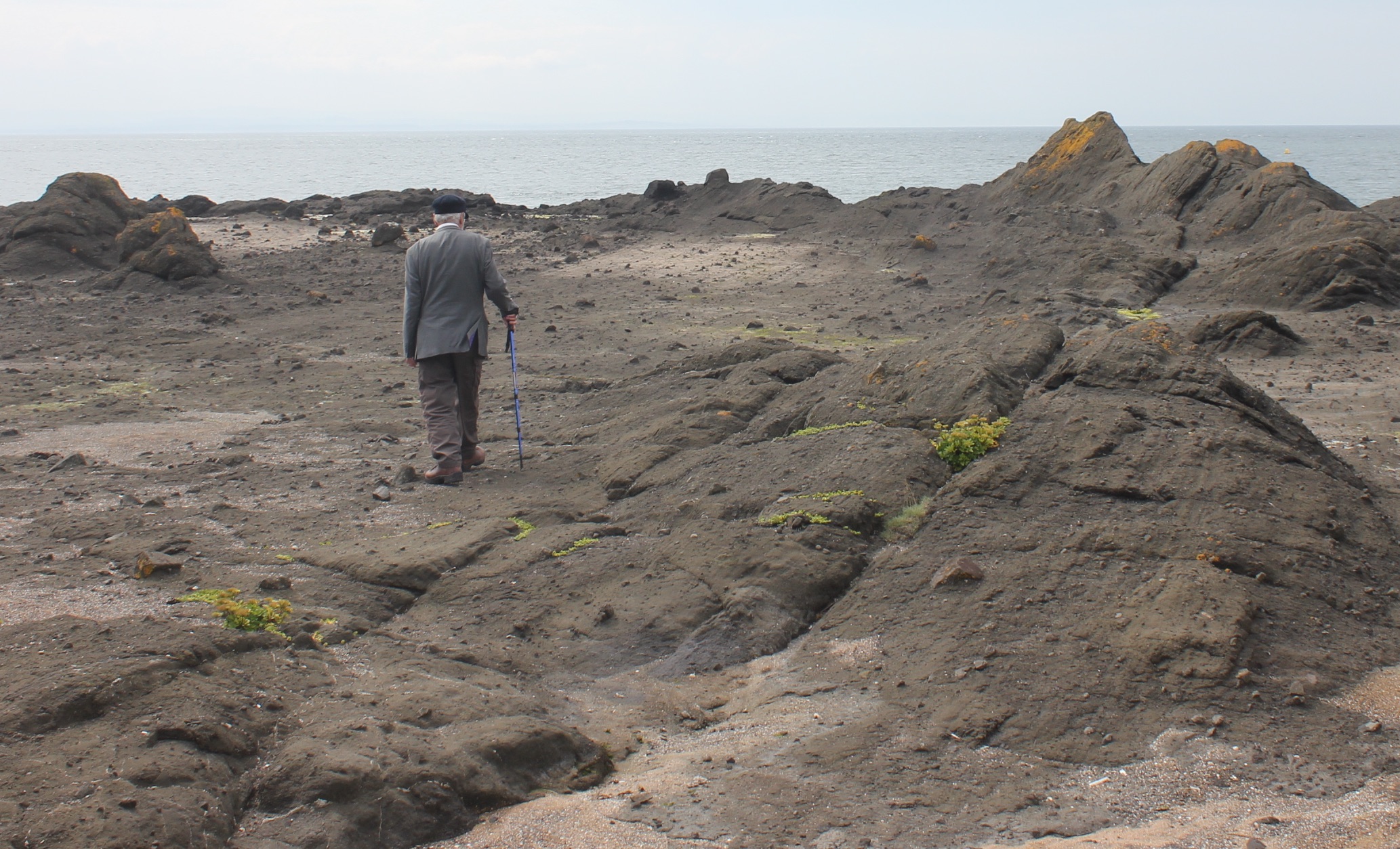
Author walking across the tuff wave-cut platform. A gentle curvature to the left in the tuffs can be picked out by the basalt blocks.
Below we reproduce in its entirety the Action Plan created by a group of geoscientists led by the Cultural Task Force of the Geological Society of America.
The petition can be found here.
“In a racist society, it is not enough to be non-racist, we must be anti-racist.” – Angela Y. Davis
What does it mean for a professional society or organization to be anti-racist and equitable to all members? For a start, they will continually ask AND answer difficult but important questions: Who benefits from the institution’s status quo? Who is left out? Who continues to hold power? Who feels safe, who does not feel safe, and why? Who do we want to attract and retain in our societies and organizations? For those that want to strive toward anti-racism and equity, we demand the enactment of the following action plan, including the development of workgroups and timelines for implementation: